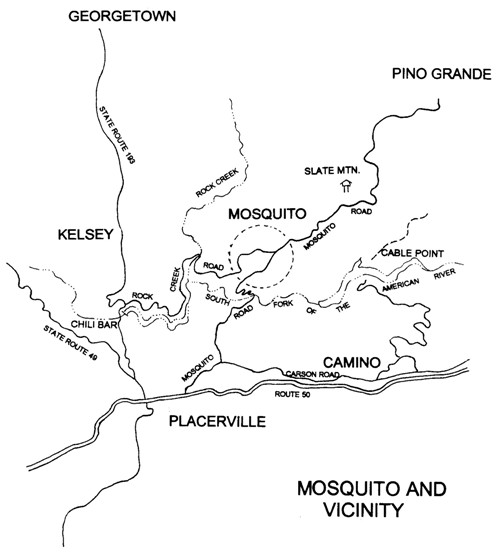History of Mosquito
By Lois Pearson
In 1849, gold mines were discovered in Mosquito Canyon. Most of the
populations settled in two different places, one being called Nelsonville and the other
Lowertown or Big House. Ben Summerfield and John Bennett on One Eye Creek built a sawmill
in 1851. In 1853, the existing name of Mosquito was given to the area.
In 1854, the Mosquito voting precinct was established and also an irrigation ditch taking
water from Slab Creek was built by the Mosquito Ditch Company, owned by James Summerfield
at a cost of $20,000.
In 1859, a road was ordered built by the County Board of Supervisors from Placerville to
Mosquito Village.
In 1860, there were 1200 voters for President Lincoln’s election, and this was before
women were allowed to vote!
In 1862 the Mosquito School was started.
In 1867, the “Swinging Bridge” was built on Mosquito Road. It is a County
Historical Landmark. The cables were made by Hiram Tipton, an Englishman, at a site near
the bridge.
In 1872, J.W. Skinner, a resident of Mosquito, was nominated for County Sheriff.
In 1882, the Mosquito School District was established, and the Mosquito Post Office was
started by Mrs. Dickenson.
During the 1880’s some local residents listed in the area included the names
Summerfield, Mechior, Finnon, Selleck, Coughlen, and Markiel.
There was a large Maidu Indian colony in the area in the mid to late 1800’s, as well
as a colony of Spaniards.
In 1905, the Swansborough family brought the Dickenson property, where the Pose Office had
been. The American River Electric Company bought up water for the AREC power house on the
American River just below the community of Mosquito.
In 1907, Finnon Lake was completed and later became a state owned, county leased
recreation area run by a private concessionaire.
Between 1911 and 1915, a telephone line was constructed between Placerville and Mosquito.
Mosquito was also one of the first areas in El Dorado County to have electric power.
In 1926, the present Swansborough house was built on the location of the one purchased
from the Dickensons which burned in 1924.
In 1934, a large C.C.C. camp was here at Mosquito with 200 or more boys at a time. It was
operated by the U.S. Army and the U.S. Forest Service. During World War II the camp housed
conscientious objectors who acted as forest service fire crews, without pay, during the
fire seasons.
From 1943 through the 1960’s, a large sawmill operated in Mosquito and logs were
brought from as far away as Bishop, California. There were also smaller,
“portable,” mills operating in the area at that time.
During these years Frank Andre, the legendary “Goat Doctor” lived here until he
passed away in 1957. People came from all over the United States for his healing touch.
In 1968, the Swansboro subdivision was started with property purchased from the
Swansborough, Darr, Morton, and Lawyer families. This was the first rural subdivision in
El Dorado County.
The Mosquito area has a unique history, which has been documented by longtime resident
and Mosquito Matriarch Lois Pearson in her booklet "Mosquito Memories,”
published by the Mosquito Volunteer Fire Department. You may contact the Mosquito
Fire Station at (530) 626-9017 to obtain your copy for $5.00. Lois passed away on
April 27, 2005.
To subscribe to the Mosquito Byte, our monthly community newsletter, click
here.
Where is Mosquito, anyway? About 10 miles northeast of Placerville,
California.

|
